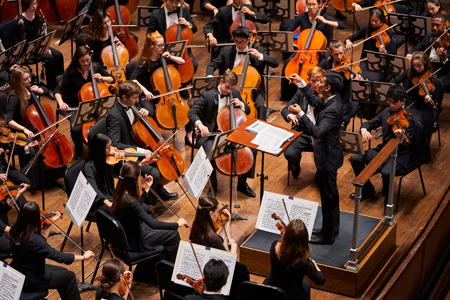by Timothy Robson

The program began with a dramatic performance of Jean Sibelius’s Symphony No. 1 in e, opening with a timpani roll and a mournful clarinet solo by Peter Varga, who confidently caught the emotion that was yet to come. Vinay Parameswaran’s conducting throughout the concert was notable for its precision and clarity. The ensemble was tight, often of a very high level. There were occasional minor lapses of intonation, particularly in the horn section — that most treacherous of instruments — but the music bounded along, until the first movement’s sudden string pizzicato ending. The slow second movement began lyrically, slowly building in tension to its climax, with a smoothly paced return to a quiet ending.
The delightful scherzo, with its strummed viola opening, was perky, featuring an excellent flute solo by Jason Suh. The tricky dialogues between wind and strings were clean and clearly articulated. Without pause, Parameswaran moved into the full string opening of the final movement, and a reprise of the symphony’s opening clarinet solo. The movement was played for all the drama that could be gleaned from the music, but Parameswaran and his musicians largely avoided the temptation to overplay the music; the sound was full, but not blasted.
The second half of the evening was devoted to two rarely-heard choral works, Howard Hanson’s Song of Democracy (1957) and Antonín Dvořák’s Te Deum, op. 103, featuring the Cleveland Orchestra Youth Chorus, immaculately prepared by their acting director, Daniel Singer. Although COYC does not produce the robust sound of their adult counterpart, the Cleveland Orchestra Chorus, their youthful voices blended beautifully, and their diction was superb.
The Song of Democracy is based on two texts by the great American poet Walt Whitman. The opening passage from “An Old Man’s Thought of School,” was a slow chorale, eventually becoming more rhythmic, with march-like snare drum figures. At times, the orchestra completely covered the choral sound.
The second passage of text, from Whitman’s Leaves of Grass, was truly inspiring. “Sail, sail thy best, ship of Democracy” was sung softly, unaccompanied at first. The metaphor of a ship sailing in turbulent waters seemed well-matched to these times of American political discord. After development, the opening music returns in a full-throated reprise. This combination of young musicians and Whitman’s classic words matched to Hanson’s music was thrilling.
Soprano Marian Vogel and baritone Brian Keith Johnson joined the chorus and orchestra for a rollicking performance of Dvořák’s joyful Te Deum of 1892. The harmonic motion of the four movements is often quite slow, with repeated figurations in the strings, giving the impression of American minimalist music, although perhaps a more accurate comparison might be to the repeated ostinati of Leoš Janáček. The setting of this great ancient Christian hymn of praise is largely syllabic, although Dvořák often repeates phrases as refrains.
Vogel’s bright, clear soprano soared over the orchestra and chorus. Johnson had more weighty music, which he sang with authority. It is hard to imagine a sacred work being this much fun to listen to, but this performance abounded in joy. Perhaps that is appropriate for a text containing the lines “Throughout each day we bless you, and we praise your name for centuries from generation to generation.” That sentiment, as embodied by these young singers and players, was certainly true for this concert.
Published on ClevelandClassical.com February 26, 2018.
Click here for a printable copy of this article


